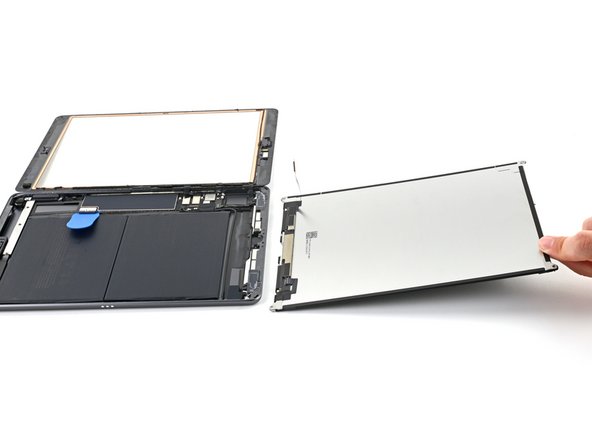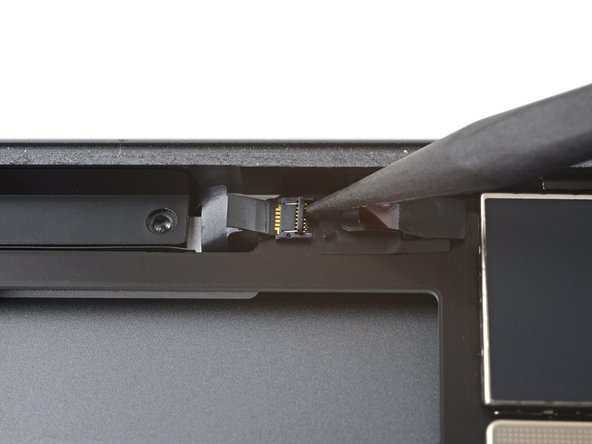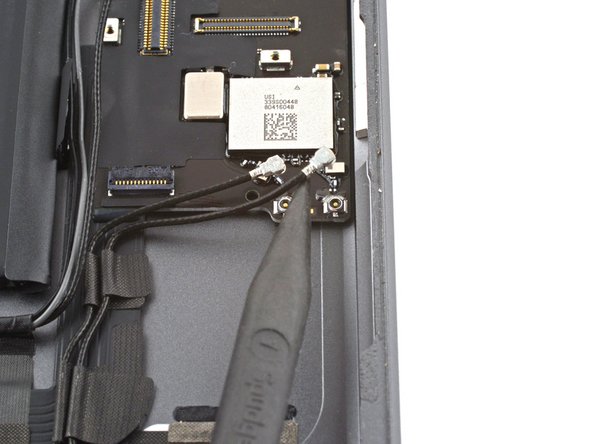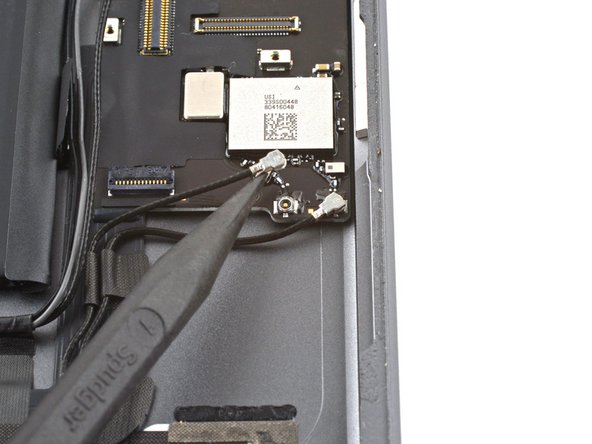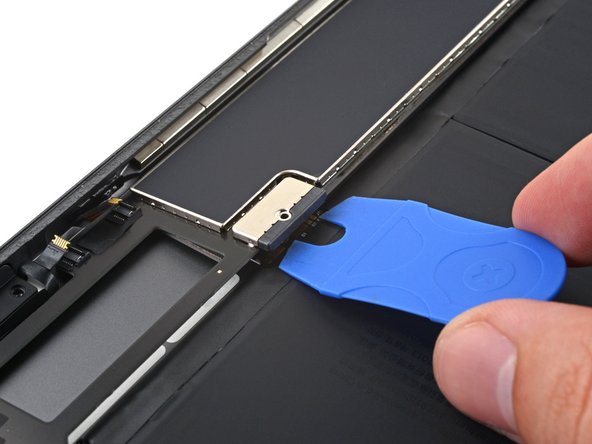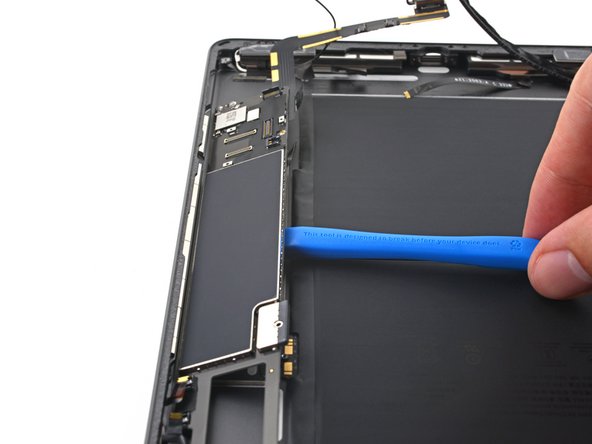iPad 8 Battery Replacement
Duration: 45 minutes
Steps: 101 Steps
For your safety, make sure to let that battery drop below 25% before diving into your iPad disassembly adventure!
Get ready to swap out the battery in your iPad 8 Wi-Fi! Just a friendly reminder: this guide is specifically for the Wi-Fi version, so if you're rocking the LTE model, make sure to check out the right guide. Before diving in, please drain that battery to below 25%—safety first! This helps avoid any fiery mishaps if things get a little hectic during the repair. If your battery looks like a balloon, proceed with caution! When you're isolating the battery with a blocker, be super gentle—those contacts can bend or break easily, leading to some serious bummer moments. If you decide to skip the isolation step, only use metal tools when absolutely necessary (like for screw removal) to keep the battery and delicate circuit components safe from a short circuit. And hey, some of the pics here may feature a different model, but don't sweat it—they won't mess with the steps you need to follow!
Step 1
- Warm up an iOpener and stick it onto the left side of your device for two minutes to loosen things up.
Tools Used
Step 2
- As the adhesive starts to give way, keep an eye out for these tricky spots that don’t like being poked:
- Front camera
- Antennas
- Display cables
Step 3
The upcoming three steps show how to use the Anti-Clamp, a handy tool designed to make opening your device a breeze. If you’re not using the Anti-Clamp, no worries—just skip ahead three steps for another way to get it done.
For a full walkthrough on using the Anti-Clamp, check out this guide.
If your iPad’s surface is feeling a bit too slick for the Anti-Clamp to grip, try adding some tape to create a better hold.
- Slide the blue handle back to release the Anti-Clamp’s arms.
- Set something under your iPad so it stays nice and level between the suction cups.
- Place the suction cups close to the center of the left side—one up top, one down low.
- Hold the bottom part of the Anti-Clamp steady and press down firmly on the top suction cup to get a good grip.
Step 4
- Slide the blue handle forward to secure the arms in place.
- Rotate the handle clockwise a full 360 degrees, or until you notice the suction cups starting to stretch.
- Keep an eye on the suction cups to make sure they stay perfectly aligned. If they start to drift, just loosen them a bit and realign the arms before continuing.
Step 5
Take it easy and only twist a half turn at a time, giving it a minute to breathe between turns. Let the Anti-Clamp and the magic of time do their thing for you.
For a complete walkthrough on how to use a hair dryer, give this guide a look.
If the Anti-Clamp isn’t making enough space, try adding a little more heat and twist the handle clockwise for half a turn.
- Take a moment and let the adhesive chill for about a minute to create a little breathing room.
- If your screen's feeling a bit chilly, warm it up a touch by running a hair dryer along the left edge of the iPad.
- When the Anti-Clamp has opened up a nice gap, slip an opening pick underneath the digitizer.
- Feel free to skip the next step!
Step 6
When your screen is looking like a shattered puzzle, slap on some clear packing tape to give the suction cup something to hold onto. If that’s not cutting it, go for some super strong tape as a backup. And hey, if you’re feeling bold, a dab of superglue can stick the suction cup right to that cracked screen.
- Once the screen feels comfortably warm to the touch, grab your suction handle and stick it firmly on the left edge of the screen, as close to the edge as possible.
- Gently lift the screen using the suction handle, creating a small gap between the digitizer and the frame. Don't rush; a little space is all you need.
- Now, carefully slide an opening pick into that gap between the digitizer and the frame. Take your time to get it in there without forcing it.
Tools Used
Step 7
No stress if you spot the opening pick peeking through the digitizer—just gently pull it out. The LCD should be totally fine, but leaving sticky adhesive behind can be a real pain to clean up later.
- Pop in a second opening pick right into the gap you just made.
- Gently slide that pick down toward the device’s bottom-left corner to loosen up the adhesive.
- Keep the pick wedged there so the adhesive doesn’t sneak back together on you.
Step 8
- If your opening pick gets stuck in the adhesive, just roll it gently along the edge of the iPad to keep that glue from holding you back.
Step 9
- Gently slide the first opening pick up towards the top-left corner of your device to break that pesky adhesive seal.
- Keep the pick in the top-left corner to stop that adhesive from getting cozy again.
Step 10
- Warm up an iOpener and stick it on the top edge of your device for a solid two minutes to get things nice and toasty.
Tools Used
Step 11
- Gently twist the pick around the upper-left corner of your device to break free that stubborn adhesive.
Step 12
Keep the pick away from the front camera lens to avoid any sneaky scratches. The next steps will help you dodge that hazard like a pro.
- Gently slide the opening pick along the top edge of the device, stopping just before you hit the front camera — take it slow and steady!
Step 13
- Gently pull the pick until just the tip is snugly nestled between the digitizer and the frame.
- Slide that pick right above the front camera to help free the adhesive like a pro.
- Now, keep the pick close to the right side of the front camera before moving on to the next step.
Step 14
- Pop the pick back in and gently slide it toward the top-right corner of your device. This will fully separate the top adhesive like a charm.
- Once you’re there, leave the pick in the top-right corner. That’ll stop the adhesive from making a sneaky reappearance and sticking back together.
Step 15
- Warm up your iOpener and give it a cozy two-minute hug on the right edge of your device. Let's get that adhesive loosened up!
Tools Used
Step 16
- Gently glide the pick around the top-right corner of your device to break that stubborn adhesive seal. You've got this!
Step 17
The display cables are hanging out around halfway up from the bottom of the iPad. Pause your sliding adventure when you get about three inches away from the bottom of the iPad.
- Grab a fresh opening pick and gently slide it right down the middle of your iPad's right edge like you're giving it a little tickle.
Step 18
- Warm up an iOpener and press it against the bottom edge of your device for about two minutes. Let the heat work its magic!
Tools Used
Step 19
Be careful not to spin the pick all the way around the corner—doing so might mess with the antenna. Keep it steady and you'll be fine!
- Gently slide the pick down to the bottom-left corner to loosen up that stubborn adhesive.
- Keep the pick right there in the bottom-left corner before moving on to the next step.
Step 20
Slide the pick gently toward the home button only—going the other way might mess up the antenna, and we don't want that!
If you find yourself needing to slide that pick over this section again, just pop it out and slide it back in from the bottom-left corner. You've got this!
- Pop in a new opening pick right where you just made that sweet gap along the bottom edge of your iPad.
- Gently glide the pick over the antenna, but hold up just before you reach the home button.
- Make sure to keep that pick on the left side of the home button before you carry on!
Step 21
Be gentle and only slide that pick in about 1 mm to keep the right antenna safe and sound!
- Pop an opening pick into the little gap you just made.
- Gently slide the pick under the home button and glide it toward the bottom-right corner, keeping just the tip tucked between the digitizer and the frame.
Step 22
Slide the pick gently toward the home button only—going the other way might mess with the antenna, and we don't want that!
If you need to glide the pick over this spot again, just pull it out and pop it back in at the bottom-right corner. Easy peasy!
- Slide the pick back in and nudge it gently towards the home button to fully loosen that bottom adhesive.
- Let the pick chill just to the right of the home button before you move on.
Step 23
- Warm up an iOpener and stick it on the right edge of your device for a solid two minutes to get things nice and toasty.
Tools Used
Step 24
Take it easy with this step! Make sure the adhesive is nice and toasty, and gently work your pick to separate all the sticky bits. And hey, if you need to reheat, don’t hesitate to hit pause and do just that!
If you're feeling some serious resistance, don't sweat it! Just reheat those edges and glide along with your trusty opening pick.
- Gently twist the two opening picks into the left corners of the iPad to lift the digitizer just enough. This will help separate the last bit of adhesive, getting you closer to your goal!
Step 25
- Gently lift the left edge of the digitizer upward to loosen the adhesive along the right side of your iPad.
Step 26
- While holding the digitizer steady, carefully insert an opening pick between the two display cables to peel away the final bits of adhesive.
Step 27
- After you've successfully peeled away all that stubborn adhesive, gently open the digitizer like a book and lay it down flat beside the iPad, just chilling out.
- As you put everything back together, take a moment to wipe away any leftover adhesive from the frame—and the digitizer if you're giving it a second life—with some isopropyl alcohol. Don't forget to replace that adhesive with our handy adhesive strips or pre-cut adhesive cards.
- Keep an eye on those display cables when you're reassembling the device! Make sure they are neatly tucked away under the LCD screen to keep everything safe and sound.
Step 28
- Grab a Phillips screwdriver and carefully remove the four 4.3mm screws holding the LCD in place. Nice and steady!
- Keep an eye on each screw as you go—make sure it finds its way back to the exact spot it came from. This will help prevent any mishaps with your device.
- Peel off any tape hiding those pesky LCD screws. You’ve got this!
Step 29
Hold off on pulling the LCD all the way out here—it's still hanging on by its flex cable, so keep it chill!
- Grab a spudger and gently ease the LCD out of its cozy spot just enough so you can get a good grip with your fingers.
- Now, flip that LCD like you're turning a page in your favorite book, lifting it near the camera and flipping it over towards the home button end of the frame.
- Place the LCD on a clean, soft, lint-free surface to give those display cables some breathing room.
Tools Used
Step 30
- Grab your Phillips screwdriver and gently unscrew the 2.3 mm-long screw holding the battery connector to the logic board. Keep it safe!
Step 31
Check out these photos that give you a sneak peek of the battery connector hiding under the logic board. Use them as your trusty guide while you carefully disconnect the battery.
You'll see that the battery connector is equipped with cantilever springs on the logic board that snugly press against the battery contact pads. Since both the logic board and battery are a bit stuck down, grab something thin and flexible to slide between those contact points to disconnect the battery.
Step 32
Heads up! When isolating the battery with a battery blocker, handle those battery contacts gently—they’re delicate and can bend or break easily, causing damage that can’t be undone.
Make sure the logo on the battery blocker is facing upwards—no upside-down surprises here!
Avoid shoving the battery blocker under the connector with brute force. If it’s being stubborn, try gently sliding a playing card underneath to disconnect the battery instead.
Ideally, the battery blocker or playing card should glide under the logic board smoothly without any obstacles. Once in place, it should sit at about a 15-degree angle, chilling comfortably.
- Gently slide the battery blocker under the logic board’s battery connector at about a 35-degree angle—smooth and steady wins the race.
- Keep that battery blocker right where it is while you continue working.
Tools Used
Step 33
- Grab a Phillips screwdriver and carefully unscrew the three tiny 1.4 mm screws holding down the display cable bracket.
Step 34
- Gently grab the display cable bracket with tweezers or your fingers and lift it out like a pro.
Tools Used
Step 35
- Grab that trusty spudger and gently lift up the LCD cable press connector like you're giving it a little hug!
- When it's time to snap those press connectors back in, make sure to line them up just right. Press down on one side until you hear that satisfying click, then work your magic on the other side.
- Remember, no need to push down in the center! If things get a bit wonky and the connector isn't aligned, you could accidentally bend the pins, and we definitely don't want that!
Tools Used
Step 36
- Carefully take off the LCD and place it face down on a clean, soft surface that won't leave any lint behind. You've got this!
Step 37
- Grab a trusty pair of tweezers and gently peel away the tape that’s keeping the home button cable ZIF connector snug and secure.
Tools Used
Step 38
- Grab a spudger, an opening tool, or even your trusty fingernail to gently lift the small, hinged locking flap on the home button cable ZIF connector. You've got this!
Tools Used
Step 39
- Grab a pair of tweezers and gently pull the home button ribbon cable straight out of the ZIF connector. You’ve got this!
Tools Used
Step 40
Be gentle and only pry on the connectors themselves—avoid messing with the socket on the logic board to keep your iPad safe and sound.
- Grab your trusty spudger and gently slide the flat end under those two digitizer cable press connectors. Give them a little nudge to pop them up and disconnect. You've got this!
Tools Used
Step 41
Watch out—don’t poke or rip the home button ribbon cable; it’s delicate and deserves some love!
- Grab your trusty spudger and gently lift up the vibration isolator located in the bottom-right corner of your device. Be gentle—you're just coaxing it out!
- Once you've raised it, go ahead and take out the vibration isolator. You're one step closer to your device's revival!
Tools Used
Step 42
The home button cable is held in place by a bit of gentle adhesive.
- Grab your trusty tweezers and gently lift the home button cable away from the frame like a pro.
Tools Used
Step 43
Grab your trusty opening pick and gently slice away any stubborn adhesive that might still be holding the front panel assembly to the frame. It's like a mini adventure in adhesive removal!
Watch out for those sneaky areas of the digitizer! Without the right insulation, they could accidentally short out against other components, leading to some frustrating touch input issues.
And just a heads-up: the insulation is a stealthy little thing—not visible to the naked eye, and quite different from the foam dust barrier strips you might find on many iPads.
- Take off the front panel assembly carefully.
- If your new display starts acting up with those annoying "ghost" or "phantom" touch inputs, try placing a super thin layer of insulating tape like Kapton (polyimide) tape on the marked spots on the back of the panel. Replacement digitizers already have this covered, so usually no extra tape needed.
- When putting things back together, make sure to scrape off any leftover adhesive from the iPad, then give the glued areas a good clean with 90% (or higher) isopropyl alcohol and a lint-free cloth. This step helps the new adhesive stick like a champ.
- Give your iPad a quick test to make sure everything is working, then apply pre-cut adhesive strips to the back of the display following the adhesive application guide before sealing it up.
Step 44
- Grab your trusty Phillips screwdriver and let's get to work! Carefully unscrew those three screws, each 1.4 mm long, that are holding the upper component bracket in place. You've got this!
Step 45
- Grab those trusty tweezers or use your fingers to gently lift away the upper component bracket from the frame. You've got this!
Tools Used
Step 46
- Gently slide the flat end of your trusty spudger under the front camera cable connector and lift it up to disconnect it with a smooth move.
Tools Used
Step 47
The front camera shell is gently stuck to the frame, so be careful as you work with it.
- Carefully slide an opening pick between the front camera housing and the frame to gently separate them.
Step 48
- Gently slide your pick around the edge of the camera shell to break through the adhesive seal.
Step 49
- Grab your opening pick and gently pry up to pop the front camera shell away from the frame.
- Now, go ahead and lift off that front camera shell!
Step 50
The front camera is stuck on the microphone assembly with some adhesive glue. Let’s gently separate them to keep everything intact!
- Slide a spudger in between the front camera and the microphone assembly.
- Gently pry upwards to break the front camera's adhesive seal.
- Carefully lift out the front camera.
Tools Used
Step 51
- Gently use the flat end of a spudger to lift and unplug the headphone jack's press connector.
- Do the same for the microphone assembly's press connector.
Tools Used
Step 52
- Gently lift the headphone jack away from the frame with your fingers, then tuck the cable to the side like a pro.
Step 53
- Grab the flat end of a spudger and gently lift the rear camera's press connector straight up to disconnect it. Easy does it!
Tools Used
Step 54
- Gently remove any tape that’s keeping the button control cable ZIF connector under wraps.
Step 55
- Gently lift the little hinged locking flap on the button control cable ZIF connector using the tip of a spudger, an opening tool, or even your trusty fingernail. You've got this!
Tools Used
Step 56
- Grab a trusty pair of tweezers and gently wiggle out that button control cable from the ZIF connector. You've got this!
Tools Used
Step 57
- Gently peel away any tape hiding the Smart Cover sensor cable ZIF connector.
Step 58
- Grab your trusty spudger, an opening tool, or even your fingernail, and gently flip up that little hinged locking flap on the Smart Cover sensor cable ZIF connector. You've got this!
Tools Used
Step 59
Hold the cable by the pull tab—resist the urge to tug on the cable itself!
- Grab a pair of tweezers and gently pull the Smart Cover sensor cable straight out of the ZIF connector. You've got this!
Tools Used
Step 60
- Grab your trusty spudger and gently pry up to disconnect the coaxial cable from the left antenna. You've got this!
- Now, let's do the same for the right antenna's coaxial cable. Easy peasy!
- When you're putting everything back together, those connectors can be a bit finicky. Just hold each one in position over its socket and give it a good push with the flat end of your spudger. You'll hear a satisfying snap when it's secure!
Tools Used
Step 61
Hold onto the antenna cable itself—not the connector—when pulling. Tugging on the connector can snap it, and that’s a bummer!
- Gently lift the right antenna cable and free it from its cozy spot.
Step 62
- Gently peel the left antenna cable off the frame, following the bottom edge of the iPad. Take your time—patience is key!
Step 63
Step 64
Peel back slowly and at a gentle angle to keep those speaker connectors safe and sound.
- Grab a pair of tweezers or use your trusty fingernail to gently lift the tape that's holding down the speaker connectors. It's time to get that sound back in action!
Tools Used
Step 65
- Gently use the tip of a spudger, an opening tool, or even your trusty fingernail to lift up the little hinged locking flap on both the left and right speaker cable ZIF connectors.
Tools Used
Step 66
- Gently grab a pair of tweezers and slide the left and right speaker cables straight out from their ZIF connectors—smooth and steady wins the race!
Tools Used
Step 67
- Grab your trusty spudger and use its sharp end to gently pry up the Smart Connector coaxial cable. Aim for the spot closest to the connector to disconnect it with ease.
Tools Used
Step 68
- Grab your trusty spudger and gently lift up the Smart Connector cable's connector to disconnect it. You've got this!
Tools Used
Step 69
- Grab your tweezers and gently lift the tape holding the Smart Connector cables to the frame—easy does it!
Tools Used
Step 70
- Gently peel the Smart Connector cables off the frame, taking care not to rush it. Give it a little wiggle, and it'll come free without a hitch!
Step 71
- Grab your trusty Phillips screwdriver and let's get those screws out! You'll need to tackle four of them that are keeping the charging port snug in the frame:
- First up, two screws that are 2.2 mm long—easy peasy!
- And don't forget the two slightly longer ones at 3.2 mm. You've got this!
Step 72
- Heat up your iOpener and gently press it against the bottom, top, and logic board side of your iPad. Give each spot about 30 seconds to warm up, making sure it gets nice and toasty in all the right places.
Tools Used
Step 73
- Slip an opening pick right under the charging port cable, just next to the port. Gently slide it towards the logic board to separate the adhesive.
Step 74
- Gently coax the charging port out of its snug little home in the frame.
Step 75
- Carefully slide an opening pick under the upper arm of the logic board and gently work it toward the board to slice through the adhesive holding it to the frame.
- Keep the pick in place to stop the adhesive from sticking back together.
Step 77
Be careful not to bend that logic board—doing so could spell disaster! If the adhesive is being extra clingy, just warm it up a bit more and give it another go!
When using your tool near the battery, be super cautious! A punctured or bent battery could leak some nasty stuff or even spark a fire. Safety first!
If the logic board is playing hard to get, gently slide an opening pick under its bottom edge to carefully cut through some of that stubborn adhesive.
- Gently slide an opening tool into the center of the logic board and apply a slow, steady pressure to lift it away from the frame. You're doing great!
Step 78
- Grab your trusty halberd spudger or an opening pick and give that stubborn adhesive a good slice to free the logic board from the frame. You've got this!
Tools Used
Step 79
- First up, let's liberate that logic board! Carefully remove it from its cozy spot.
- As you start putting everything back together, make sure there are no sneaky ribbon cables hiding under the logic board before you stick it down with glue.
- And don't forget—while reassembling, grab some high-strength isopropyl alcohol (90% or greater) to wipe away any leftover adhesive. Then, use strips of Tesa tape to give your Logic Board a solid hug to the chassis!
Step 80
Before you start removing the battery, make sure to keep the other components safe. A little tape over them goes a long way!
Run your finger along the edge of the tape to make sure it sticks nicely. You want that seal to be tight!
- Grab a strip of painter's tape or Scotch tape, cutting it to match the width of your iPad.
- Stick the bottom edge of the tape strip onto the back case right above the speakers and bottom antennas.
- Press down the top edge of the tape over the lower components to keep any cables out of the way when removing the battery.
Step 81
- Now, repeat the taping process for the top components. Make sure everything sticks securely so you're on the right track!
Step 82
iFixit adhesive remover has acetone in it, which can be a bit of a troublemaker for your skin and eyes. Handle with care, and if things get tricky, just remember you can always schedule a repair.
- Make sure to rock those safety glasses when you're working with that adhesive remover!
- Skip the contact lenses for now—safety first, right?
- Your kit comes with protective gloves. If you're worried about skin irritation, go ahead and slip those gloves on before we dive in!
Tools Used
Step 83
Give that bottle cap a little twist to loosen it up before you snip the applicator tip. It's like a pre-party warm-up!
And don’t forget to twist that bottle cap back on tightly before you dive into the next step. Let's keep everything sealed up and ready to go!
Give the bottle a little pop to break the seal and even out the pressure before you snip the applicator tip. Skip this, and the adhesive remover might surprise you with a spray when you cut it open.
Snipping close to the skinny end gives you sharper control, so you can apply the adhesive remover in just the right small doses.
- Take off the black rubber cap from your adhesive remover bottle.
- Grab some scissors and snip off the sealed tip of the applicator.
Step 84
- The red boxes highlight where you'll find the adhesive strips that hold the battery snugly to the back case. Time to get that battery free and clear!
Step 85
- Drop a little bit of adhesive remover or high-concentration isopropyl alcohol along the left edge of the battery. Let it work its magic, making it easier to separate things when you’re ready.
Step 86
- Pour a few drops of adhesive remover or high-concentration isopropyl alcohol along the lower edge of the battery to loosen things up a bit.
Step 87
- Gently drip a few drops of adhesive remover or some strong isopropyl alcohol right between the two battery cells to loosen things up.
Step 88
- Drop a few splashes of adhesive remover or some high-concentration isopropyl alcohol along the right edge of the battery. This will help loosen things up a bit.
Step 89
- Gently drop a few drops of adhesive remover or some strong isopropyl alcohol along the top edge of the battery to loosen things up.
Step 90
Handle the battery with care and avoid poking or bending it with your tools—doing so could cause the battery to leak some not-so-fun chemicals or spark a thermal surprise!
Struggling with a stubborn battery? No worries! Try adding a little more adhesive remover, or use a heated iOpener on the back case to loosen things up.
- Slide a plastic card gently into the bottom right corner of the battery to get things moving.
Tools Used
Step 91
- Slide the plastic card under the right edge, aiming for the center like a pro.
- Push that card in as far as you can go beneath the battery to slice through the adhesive.
- Pull the plastic card out and admire your handiwork.
Step 92
- Slide the plastic card under the battery connector, pushing it in as far as it will go.
- Keep the plastic card in place for now.
Step 93
- Slide another plastic card just above the battery connector, pushing it in as far as it will comfortably go.
Step 94
- Slide the plastic card out from under the battery connector and tuck it beneath the bottom edge of the battery to gently pry it up.
Step 95
- Gently glide that trusty plastic card along the bottom edge of the battery to slice through the adhesive strip. You've got this!
- When you hit the left corner of the bottom edge, slide that card in as far as it will go. Keep going, you're almost there!
Step 96
If the battery is being stubborn, try adding a bit more adhesive remover or warming up the back case with a heated iOpener to help loosen things up.
- Time to get that battery out! Start by sliding a plastic card above the battery connector right under the upper edge of the battery. You're doing great!
- Now, gently glide the plastic card along the top edge of the battery to slice through the adhesive strip. Keep it steady and you're almost there!
Tools Used
Step 97
- When you get to the left corner of the top edge, slide that plastic card in as far as it will go.
Step 98
- Start by gently slipping the plastic card under the upper left corner of the battery. Take your time—it’s all about finesse.
- Now, slowly glide the plastic card downwards towards the bottom of the iPad. Keep it steady and smooth for that perfect cut.
- When you hit the center edge of the battery, push the card as deep as you can to slice through the adhesive strip. This step is the magic that makes everything come apart!
Step 99
- Slide that trusty plastic card right under the bottom left corner of the battery. You've got this!
- Now, gently glide the card upwards towards the top of the iPad. Keep it smooth and steady!
Step 100
- As you approach the center edge, slide the plastic card in as deep as it will go to slice through that central adhesive strip. Keep it steady, and you'll be good to go!
Step 101
Once you've taken that battery out, it's time to say goodbye! Reusing it could lead to some serious safety issues, so grab a shiny new battery instead.
Still having trouble with that battery? No worries! Just go ahead and repeat the process of slicing through the battery adhesive a bit more. It'll budge eventually!
- Now that you've got everything back together, just retrace your steps to reassemble your device.
- For smooth sailing, don't forget to calibrate your new battery after finishing up this guide.
- Got e-waste? Make sure to drop it off with an R2 or e-Stewards certified recycler to keep things green!
- Repair didn’t go as planned? No worries! Try a little troubleshooting or reach out to our helpful community for some extra tips.





























































































